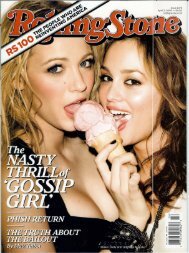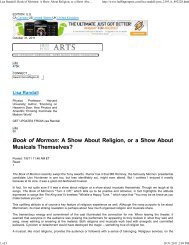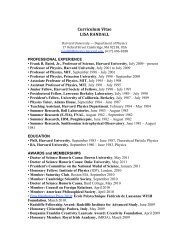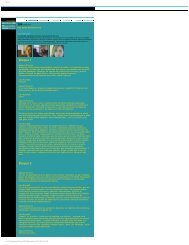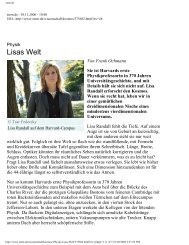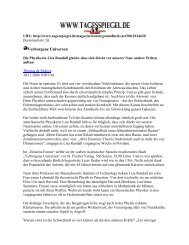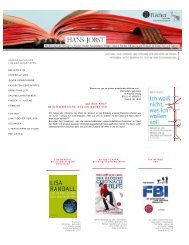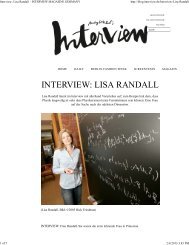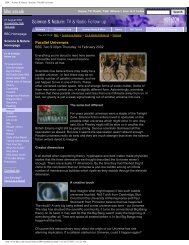BBC - Science & Nature - Horizon - Parallel Universes - Transcript
BBC - Science & Nature - Horizon - Parallel Universes - Transcript
BBC - Science & Nature - Horizon - Parallel Universes - Transcript
- No tags were found...
Create successful ePaper yourself
Turn your PDF publications into a flip-book with our unique Google optimized e-Paper software.
<strong>BBC</strong> - <strong>Science</strong> & <strong>Nature</strong> - <strong>Horizon</strong> - <strong>Parallel</strong> <strong>Universes</strong> - <strong>Transcript</strong>Home TV Radio Talk Where I Live A-Z Index27 August 2007Accessibility helpText only<strong>BBC</strong> Homepage<strong>Science</strong> & <strong>Nature</strong>HomepageAnimals Prehistoric Life Human Body & Mind Space Hot Topics TV & Radio Follow-upYou are here: <strong>BBC</strong> > <strong>Science</strong> & <strong>Nature</strong> > TV & Radio Follow-up > <strong>Horizon</strong><strong>Parallel</strong> <strong>Universes</strong><strong>BBC</strong> Two 9.00pm Thursday 14 February 2002In TV & Radiofollow-up:TV programmesAnimal HospitalBig Cat DiaryBill Oddie Goes WildBritain Goes WildBritish Isles: A NaturalHistoryCountryfileCousinsDangerous PassionsDragons AliveGeronimoHawking<strong>Horizon</strong>JungleLeonardoLife on AirNileShould I WorryAbout...?RobotsState of the PlanetTalking with AnimalsTest Your PetWhat Am I Like?Wild AfricaWild Down UnderTV & radio listingsPresentersContact UsLike this page?Send it to a friend!NARRATOR (DILLY BARLOW): Imagine you could find an explanation foreverything in the Universe, from the smallest events possible to the biggest. This isthe dream which has captivated the most brilliant scientists since Einstein. Nowthey think they may have found it. The theory is breathtaking and it has anextraordinary conclusion: that the Universe we live in is not the only one.MICHIO KAKU (City University of New York): That there could be an infinitenumber of universes each with a different law of physics. Our Universe could bejust one bubble floating in an ocean of other bubbles.NARRATOR: Everything you are about to hear is true, at least in this Universe it is.For almost a hundred years science has been haunted by a dark secret: that theremight be mysterious hidden worlds beyond our human senses. Mystics had longclaimed there were such places. They were, they said, full of ghosts and spirits.The last thing science wanted was to be associated with such superstition, but eversince the 1920s physicists have been trying to make sense of an uncomfortablediscovery. When they tried to pinpoint the exact location of atomic particles likeelectrons they found it was utterly impossible. They had no single location.ALAN GUTH (Massachusetts Institute of Technology): When one studies theproperties of atoms one found that the reality is far stranger than anybody wouldhave invented in the form of fiction. Particles really do have the possibility of, insome sense, being in more than one place at one time.NARRATOR: The only explanation which anyone could come up with is that theparticles don't just exist in our Universe. They flit into existence in other universes,too and there are an infinite number of these parallel universes, all of them slightlydifferent. In effect, there's a parallel universe in which Napoleon won the Battle ofWaterloo. In another the British Empire held on to its American colony. In one youwere never born.ALAN GUTH: Essentially anything that can happen does happen in one of thealternatives which means that superimposed on top of the Universe that we knowof is an alternative universe where Al Gore is President and Elvis Presley is stillalive.http://www.bbc.co.uk/science/horizon/2001/parallelunitrans.shtml (1 of 11)8/27/2007 11:12:58 AM
<strong>BBC</strong> - <strong>Science</strong> & <strong>Nature</strong> - <strong>Horizon</strong> - <strong>Parallel</strong> <strong>Universes</strong> - <strong>Transcript</strong>NARRATOR: This idea was so uncomfortable that for decades scientists dismissedit, but in time parallel universes would make a spectacular comeback. This timethey'd be different, they'd be even stranger than Elvis being alive. There's an oldproverb that says: be careful what you wish for in case your wish comes true. Themost fervent wish of physics has long been that it could find a single elegant theorywhich would sum up everything in our Universe. It was this dream which wouldlead unwittingly to the rediscovery of parallel universes. It's a dream which hasdriven the work of almost every physicist.MICHIO KAKU: On the ice rink I am communing with the fundamental laws ofphysics. At the instant of creation we believe that the Universe was symmetrical, itwas pure, it was elegant. Without friction Newtonian laws are laid bare, simple,elegant and beautiful, pure, noble, elemental, just like it was at the beginning oftime. When I was a child of eight my elementary school teacher came in the roomand announced that a great scientist had just died and on the evening news thatnight everyone was flashing pictures of his desk with the unfinished manuscript ofhis greatest work. I wanted to know what was in that manuscript. Years later Ifound out that it was the attempt of Albert Einstein to create a Theory of Everything,a theory of the Universe and I wanted to be part of that quest.NARRATOR: Einstein never achieved his goal of a Theory of Everything, but againand again others have thought they were on the brink of this ultimate achievement.This was always wishful thinking - until recently. A revolution occurred in the 1980s.In universities across the world new ideas in science streamed forth. Finally, itseemed, everything in the Universe was about to be explained. In Britain thefamous physicist Stephen Hawking, was even so confident he claimed physics wasready to read the mind of God. There would soon be no big scientific problems left.One idea was the most revolutionary of all. It seemed a sure fire Theory ofEverything and captured the imagination of scientists like Burt Ovrut. It was all todo with string.BURT OVRUT (University of Pennsylvania): It has been thought since physicsbegan that matter was made up of particles. We had changed that point of viewnow. We now think that matter is made up of little strings.NARRATOR: For years it had been an article of faith that all the matter in theUniverse was made of tiny, invisible particles. Now suddenly the particle physicistsdiscovered they'd been studying the wrong thing. The particles were really tiny,invisible strings. The theory was called String Theory and it maintained that matteremanated from these tiny strings like music.BURT OVRUT: You can think of it as a violin string or a guitar string. If you pluck itin a certain way you get a certain frequency, but if you pluck it a different way youcan get more frequencies on this string and in fact you have different notes. <strong>Nature</strong>is made of all the little notes, the musical notes, that are played on these superstrings.MICHIO KAKU: All of a sudden we realised the Universe is a symphony and thelaws of physics are harmonies of a super-string.NARRATOR: String Theory was so provocative and downright weird that itimmediately began to sound like a perfect Theory of Everything.BURT OVRUT: It certainly did sweep us all by storm. It's a beautiful, elegant andsimple theory and a number of people said well if it's so elegant and simple whydon't we try to use it as the basic unifying principle for nature.NARRATOR: But if String Theory was to become Einstein's missing Theory ofEverything it would have to pass one test. It would have to explain a rather specialhttp://www.bbc.co.uk/science/horizon/2001/parallelunitrans.shtml (2 of 11)8/27/2007 11:12:58 AM
<strong>BBC</strong> - <strong>Science</strong> & <strong>Nature</strong> - <strong>Horizon</strong> - <strong>Parallel</strong> <strong>Universes</strong> - <strong>Transcript</strong>event: the birth of the Universe. The origins of the Universe had always been thespecial subject of the cosmologists who studied the big world of stars and galaxies.They, too, felt they were on the verge of a great triumph, a complete understandingof how the world had begun. They'd long known things had started with a giantexplosion - the Big Bang - but by now cosmologists had refined the idea. They hadworked backwards in time from the present day, closer and closer to the instant ofthe Big Bang. Their work was incredibly precise.PAUL STEINHARDT (Princeton University): We have confidence in extrapolatingback from the present to when the first stars and galaxies formed and the Universewas only a billion years old, or extrapolating back farther to when the first atomswere formed, when the Universe was a few hundred thousand years old, or whenthe first nuclei formed when the Universe was only a few seconds old.ALAN GUTH: Physics was now actually ready to talk about these bizarre soundingevents in the Universe, fractions of a second and even billionths and billionths andbillionths of a second, 10 -35 seconds after the instant of the Big Bang. Absolutelyfantastic.NARRATOR: If everything in the Universe was to be explained then String Theoryand the Big Bang would now seamlessly merge and they'd complement each otherperfectly. After all, one concerned the birth of the Universe and the other all thematter in it. It was surely a foregone conclusion. Physics seemed to be on the edgeof glory, but it all went terribly wrong. Try as they might they just couldn't get thetwo ideas to merge and then, after 10 years of struggling, something even worsehappened: their two pet theories now began to self-destruct. The first problemappeared with the Big Bang. The cosmologists had assumed that as they workedbackwards in time they would eventually work their way back all the way to thebeginning of the Big Bang. There would be no awkward gaps, but after years ofend-less refinement there was one gap which refused to disappear, the mostimportant one of all.ALAN GUTH: In spite of the fact that we call it the Big Bang Theory it really saysabsolutely nothing about the Big Bang. It doesn't tell us what banged, why itbanged, what caused it to bang. It doesn't even describe, doesn't really allow us topredict what the conditions are immediately after this bang.MICHIO KAKU: The fundamental problem of cosmology is that the laws of physicsas we know them break down at the instant of the Big Bang. Well some people saywhat's wrong with that, what's wrong with having the laws of physics collapse? Wellfor a physicist this is a disaster. All our lives we've dedicated to the proposition thatthe Universe obeys knowable laws, laws that can be written down in the languageof mathematics and here we have the centrepiece of the Universe itself, a missingpiece beyond physical law.NARRATOR: The very beginning of the Big Bang was the single biggest mystery inall of cosmology. It was called the singularity.PAUL STEINHARDT: When you extrapolate Einstein's general Theory of Relativityback to the beginning you discover what we call a singularity, a cosmic singularity,which is to say that the equations blow up.NARRATOR: But the problem with the Big Bang was soon overshadowed. Thestrings were in trouble, too. The hope had been that String Theory would evolveinto the single definitive explanation for the Universe, but as more and more peopleworked on it something puzzling happened. The physicists found a second versionof it and then a third. Soon they had found five different String Theories. Thatwasn't single and it didn't sound very definitive.http://www.bbc.co.uk/science/horizon/2001/parallelunitrans.shtml (3 of 11)8/27/2007 11:12:58 AM
<strong>BBC</strong> - <strong>Science</strong> & <strong>Nature</strong> - <strong>Horizon</strong> - <strong>Parallel</strong> <strong>Universes</strong> - <strong>Transcript</strong>BURT OVRUT: Five, even though it's not a very large number, is too large for usbecause we would like to have a more unique theory than that and this definitelywas a problem, was a great crisis, so a lot of time was spent studying thoseindividual five theories, but in the back of our minds always was why are there fiveof these things, shouldn't there only be one?NARRATOR: String Theory had begun to unravel. It seemed as if the dream of aTheory of Everything was as far away as ever.MICHIO KAKU: Cynics began to come out and say that String Theory is too hard,it's a dead end, it's simply not the way to go and it's not the Theory of Everything,it's the theory of nothing.NARRATOR: But just as the scientists were about to give up hope, a new andstartling discovery would be made. This would inspire them to begin their questagain and force them at last to confront their least popular ides: parallel universes.When String Theory fell apart, not everyone was distraught. Some people evenseemed to relish the fact.MICHAEL DUFF (University of Michigan): If String Theory really was this so-calledTheory of Everything five theories of everything seems like an embarrassment ofriches.NARRATOR: Michael Duff had been the rising star of an earlier idea called supergravity. String Theory had displaced it and almost destroyed Duff's career.MICHAEL DUFF: Physics tend to be dictated by fad and fashion. There are thegurus who dictate the direction in which new ideas grow. It was a very lonely timein many ways. When I tried to get graduate students interested many of themwould say well look, you may be right and you may be wrong, but if I work in supergravity I'm not going to find a job.NARRATOR: What made the experience of the super gravity guys so galling wasthat their theory wasn't so very different from String Theory to begin with. In fact,the main disagreement between them was a point of detail which, to outsiders,could seem like nitpicking. It was about the number of dimensions in the Universe.We normally think of ourselves as living in a three-dimensional world. We canmove in three ways: left or right, up or down, and forwards and backwards, butphysics liked adding extra dimensions. Einstein suggested time should be a fourthdimension. Then someone suggested a fifth special dimension and then a sixth.The numbers just kept growing. The extra dimensions were spaces in the Universewhich we could never perceive. Most were microscopically small, but scientistsbelieved they were really there. String Theory had been convinced there were intotal exactly 10 dimensions.BURT OVRUT: Now if you have a little oscillating string it has to have enough roomto oscillate properly and when one works this out mathematically you find it, it justgot a very clear answer. It had to be in 10 dimensional space.MICHIO KAKU: Ten dimensions.BURT OVRUT: Nine spatial dimensions and one time.NARRATOR: Super gravity though had been convinced there were exactly elevendimensions.MICHAEL DUFF: The equations of super gravity took their simplest and mostelegant form when written in this 11 dimensional framework.http://www.bbc.co.uk/science/horizon/2001/parallelunitrans.shtml (4 of 11)8/27/2007 11:12:58 AM
<strong>BBC</strong> - <strong>Science</strong> & <strong>Nature</strong> - <strong>Horizon</strong> - <strong>Parallel</strong> <strong>Universes</strong> - <strong>Transcript</strong>MICHIO KAKU: There was a war between the tenth dimension and the eleventhdimension. In the 10-dimensional bandwagon we had string theorists, hundreds ofthem, working to tease out all the properties of the known universe from oneframework: a vibrating string and then we had this small band of outcasts, outlaws,working in the eleventh dimension.NARRATOR: While String Theory was in its ascendancy, few took seriously theeleventh dimension, but the super gravity guys never gave up hope.MICHAEL DUFF: I did at bottom always feel convinced that eventually 11dimensions would have its day. I wasn't sure when and I wasn't sure how, but I feltconvinced that sooner or later 11 dimensions would be seen to be at the heart ofthings.NARRATOR: But by now the boot was on the other foot. String Theory was introuble. Its five different versions meant it couldn't be the all embracing theoryphysics was looking for. Everything, it seemed, had been tried to save StringTheory. Well, almost everything.MICHAEL DUFF: An astonishing announcement was made.MICHIO KAKU: It was yet another shockwave that revolutionised the wholelandscape.NARRATOR: In a final desperate move the string theorists tried adding one lastthing to their cherished idea. They added the very thing they had spent a decaderubbishing: the eleventh dimension. Now something almost magical happened tothe five competing String Theories.BURT OVRUT: The answer turned out to be - and it really was absolutelyremarkable, I mean it really is remarkable - it turns out that they were all the same.These five String Theories turned out to be simply different manifestations of amore fundamental theory, precisely this theory which we had discarded back in theearly 1980s.MICHIO KAKU: In 11 dimensions looking from the mountain-top, looking down youcould see String Theory as being part of a much larger reality, reality of theeleventh dimension.MICHAEL DUFF: Well it was a wonderful feeling to think that all those years spentin the eleventh dimension were not completely wasted.NARRATOR: The two camps had been absolutely certain the other was wrong.Now, suddenly, they realised their ideas complemented each other perfectly. Withthe addition of one extra dimension String Theory made sense again, but it hadbecome a very different kind of theory.BURT OVRUT: What happened to the string?NARRATOR: The tiny invisible strings of String Theory was supposed to be thefundamental building blocks of all the matter in the Universe, but now, with theaddition of the eleventh dimension, they changed. They stretched and theycombined. The astonishing conclusion was that all the matter in the Universe wasconnected to one vast structure: a membrane. In effect our entire Universe is amembrane. The quest to explain everything in the Universe could begin again andat its heart would be this new theory. It was dubbed Membrane Theory, or MTheory, but so enigmatic and profound did the idea seem that some thought Mshould stand for other things.http://www.bbc.co.uk/science/horizon/2001/parallelunitrans.shtml (5 of 11)8/27/2007 11:12:58 AM
<strong>BBC</strong> - <strong>Science</strong> & <strong>Nature</strong> - <strong>Horizon</strong> - <strong>Parallel</strong> <strong>Universes</strong> - <strong>Transcript</strong>BURT OVRUT: M Theory.MICHAEL DUFF: Where M stands for magic, mystery or membrane.BURT OVRUT: M theory.PAUL STEINHARDT: Physicists get kind of dreamy-eyed when they talk about MTheory.BURT OVRUT: M Theory.MICHIO KAKU: Maybe M stands for mother, the mother of all strings. Maybe it'smagic. Maybe it's the majesty, the majesty of a comprehensive theory of theUniverse.BURT OVRUT: M Theory.NEIL TUROK (Cambridge University): Magical mystery, madness.BURT OVRUT: M Theory.NARRATOR: With M Theory it seemed at last there was a theory which mightexplain everything in the Universe, but before they could decide if this was true thescientists needed to know more about this new eleventh dimension. It quicklybecame clear it was a place where all the normal rules of common-sense havebeen abandoned. For one thing it is both infinitely long, but only a very smalldistance across.PAUL STEINHARDT: That eleventh dimension will, at its maximum size, could besomething like a trillionth of a millimetre.BURT OVRUT: Well this is 10 to the -20 of a millimetre. That's taking a millimetreand dividing it by 10 with 20 zeros after it, so that's very, very small.NARRATOR: That means that it exists only one trillionth of a millimetre from everypoint in our three-dimensional world. It's closer than your clothes to your body andyet we can't sense it. In this mysterious space our membrane Universe is floating.At first no one could imagine how that worked. Then some suggested it might floatlike a thin rubber sheet. Others that it might be more like a bubble which vibratedas it was blown aimlessly across hyperspace. If all this wasn't surreal enough, itwas then proposed that there might be another membrane universe pulsating atthe opposite end of the eleventh dimension. At first this idea wasn't taken veryseriously, but eventually it would be re-examined for physics was about to askwhether our Universe was really alone. It began with Lisa Randall.LISA RANDALL (Harvard University): People look at rock climbing and it's ofcourse very physical, but you also find that you can concentrate on one little thing. Ilike solving problems, I like games, I like figuring things out.NARRATOR: Randall had been fascinated by an apparently inexplicablephenomenon: the weakness of gravity.LISA RANDALL: There are various forces we see in nature. Most of them weunderstand at some level and then there's gravity which seems very different. Thegravitational force is extremely weak in comparison with the other forces. Now youmight look around and say gravity doesn't seem weak, but if you think about it youhave the entire Earth pulling on you and yet you can manage to pick things up.http://www.bbc.co.uk/science/horizon/2001/parallelunitrans.shtml (6 of 11)8/27/2007 11:12:58 AM
<strong>BBC</strong> - <strong>Science</strong> & <strong>Nature</strong> - <strong>Horizon</strong> - <strong>Parallel</strong> <strong>Universes</strong> - <strong>Transcript</strong>NIMA ARKANI-HAMED (Harvard University): Gravity certainly does not look weakin everyday life. It's responsible for keeping our feet on the ground and keepingEarth spinning around the Sun and so on, but actually gravity is incredibly weakcompared to the, to the other forces. This is easy to appreciate if you take anordinary refrigerator magnet and stick it on top of a metal pin. We all know thisfridge magnet will actually pick that pin up off the table, so that sort of dramaticallyillustrates how feeble gravity is compared even to the magnetic force of a tinyfridge magnet.LISA RANDALL: It turns out that there are very new ideas on how to explain theweakness of gravity if we have extra dimensions.NARRATOR: When M Theory emerged, Randall and her colleagues wondered if itmight provide the explanation. Could gravity be leaking from our Universe into theempty space of the eleventh dimensions?NIMA ARKANI-HAMED: Gravity might only appear to be weak even though it'sfundamentally just as strong as everything else because it dilutes its strength out inall these extra dimensions that we can't see.NARRATOR: Randall tried to calculate how gravity could leak from our membraneUniverse into empty space, but she couldn't make it work. Then she heard thetheory that there might be another membrane in the eleventh dimension. Now shehad a really strange thought. What if gravity wasn't leaking from our Universe but toit? What if it came from that other universe? On that membrane, or brane, gravitywould be as strong as the other forces, but by the time it reached us it would onlybe a faint signal. Now when she reworked her calculations everything fitted exactly.LISA RANDALL: If you were to imagine that there are two membranes. Say there'sone in which we sit and one in which if there's other stuff it sits there, but not ourparticles, not the stuff that we're made of and not the stuff that we see forcesassociated with. If we live anywhere else in the extra dimension we would seegravity as very weak because it's mostly spending its time near the other brane.We only see the tail end of gravity.NARRATOR: The weakness of gravity could at last be explained, but only byintroducing the idea of a parallel universe. Randall's idea opened a Pandora's Box.Now suddenly physicists all over the world piled into the eleventh dimension tryingto solve age-old problems and every time it seemed the perfect explanation wasanother parallel universe. Everywhere they looked it seemed they began to findmore and more of them. From every corner of the eleventh dimension paralleluniverses came crawling out of the woodwork. Some took the form of threedimensionalmembranes, like our own Universe. Others were merely sheets ofenergy. Then there were cylindrical and even looped membranes. Within no time atall the eleventh dimension seemed to be jam-packed full of membranes.MICHIO KAKU: We began to ask ourselves the question: who lives in the eleventhdimension? We have intersecting membranes, we have membranes with holes inthem, we have membranes that look like doughnuts or have many different kinds ofdoughnut holes. We're just littered with different kinds of membranes.MICHAEL DUFF: This eleventh dimension not only had the membrane which wasthe bubble-like or sheet-like object, but it had a whole wealth of different branes ofvarying dimensions, unfortunately called pea branes.NARRATOR: Each of these membranes was a possible other universe. M Theoryhad unwittingly made the idea of parallel universes respectable again.http://www.bbc.co.uk/science/horizon/2001/parallelunitrans.shtml (7 of 11)8/27/2007 11:12:58 AM
<strong>BBC</strong> - <strong>Science</strong> & <strong>Nature</strong> - <strong>Horizon</strong> - <strong>Parallel</strong> <strong>Universes</strong> - <strong>Transcript</strong>MICHIO KAKU: In another universe the proton may be unstable, in which caseatoms would dissolve and DNA cannot form and therefore there's no intelligent lifein these universes. Perhaps it's a universe of electrons and electricity, perhaps auniverse of lightening bolts and neutrinos, but no stable matter.MICHAEL DUFF: The other universes are parallel to ours and may be quite closeto ours, but of which we'd never be aware. They may be completely different withcompletely different laws of nature operating.ALAN GUTH: It may not all have life, but some fraction of them will have life andwhatever that fraction is if there's an infinite number of these universes there'll bean infinite number of universes that have living civilisations.MICHIO KAKU: Some of these universes may look just like ours, except perhapsyou're not there.NARRATOR: M Theory was getting stranger and stranger, but could it really be atheory which explained everything in our Universe? To have any chance of that itwould have to do something no other rival theory had ever been able to do. Itwould have to make sense of the baffling singularity at the beginning of the BigBang. M Theory was about to come up with a suitably outrageous answer andparallel universes would be at the very heart of it.BURT OVRUT: I was a teenager, I don't remember quite when it was and I don'tremember precisely why my father and I were down in Manhattan at the harbour.One of the great ocean liners at the time was the Michelangelo and it was inharbour I remember on the west side of Manhattan. Must have been near 42ndStreet. It was a remarkable sight. It's an enormous ship, let's say 150 or 200ft high,and the entire superstructure in the front of the ship, the entire bow had been justcrushed by a wave which had blown out all of the windows in the forward bulkheadright up to the bridge. This is one of what they call a white wave, or a rogue wavewhich had hit the Michelangelo and done all this damage. What's interesting is thatthere are waves somewhat similar to this which inhabit the higher dimensions andthen you can imagine if you had this huge rogue wave moving through the higherdimension if it slams into another wave you're going to have a tremendouscataclysmic collision.NARRATOR: Waves had long fascinated Burt Ovrut. Now they were just about toturn M Theory upside down. At the beginning of 2001 the received wisdom wasthat the eleventh dimension was a tranquil place with membrane universes gentlyfloating in it, but Burt suggested a much more exciting idea. <strong>Universes</strong> movingthrough the eleventh dimension like giant, turbulent waves.BURT OVRUT: These things can move. They are not static, they're, you know, likeeverything else in the world they can move around and there's not much room forthem to move in. In fact if they move they're very likely to bang into each other. Infact they either move away from each other, or they bang into each other, and onething that had occurred to me very early on is what happens if they collide?NARRATOR: To a new generation of cosmologists like Neil Turok Burt's vision ofthe eleventh dimension sounded intriguing, but he and his colleagues had otherthings on their mind. They were still wrestling with the big problems of cosmology.NEIL TUROK: Was there a beginning? Did time continue before the Big Bang?Where did the Universe come from?NARRATOR: Above all, they were still trying to solve the biggest problem of all:what caused the very start of the Big Bang, the singularity?http://www.bbc.co.uk/science/horizon/2001/parallelunitrans.shtml (8 of 11)8/27/2007 11:12:58 AM
<strong>BBC</strong> - <strong>Science</strong> & <strong>Nature</strong> - <strong>Horizon</strong> - <strong>Parallel</strong> <strong>Universes</strong> - <strong>Transcript</strong>NEIL TUROK: Nobody has a solution for the singularity problem other thanessentially by hand starting the Universe at a certain time and saying let's go fromthere and let's not worry about what happened before and that's veryunsatisfactory. This is the deepest problem in cosmology. If you can get throughthe singularity you're on your way to a complete theory of the Universe.NARRATOR: Most cosmologists have begun to think they might never find asolution. They'd almost given up completely, which is when Turok and hiscolleagues heard Burt explain his idea properly for the first time. At a conference inCambridge pioneers of M Theory had been brought together to explore itsimplications. Burt was the star of the show. His vision of a violent eleventhdimension wowed the assembled physicists and caught the attention of thecosmologists.PAUL STEINHARDT: We heard about a vast variety of ideas. The ideas that struckboth Neil and myself most strongly were the ideas that Burt presented.NARRATOR: On the last day of the conference Neil Turok, Paul Steinhardt andBurt decided to take time out. They went to see a play.BURT OVRUT: We wanted to see the play Copenhagen which was beingperformed in London at the time and the three of us took the train down to Londonone evening and we had whatever it was, an hour or so on the train to sit and talkabout these ideas.NARRATOR: On the journey they began to throw ideas around. Three physicists,one train, and the biggest secret about our Universe: what caused the Big Bang.PAUL STEINHARDT: I think people get the wrong impression about scientists inthat they think in an orderly, rigid way from step 1 to step 2 to step 3. What reallyhappens that often you make some imaginative leap which at the time may seemnonsensical. When you capture the field at those stages it looks like poetry inwhich you are imagining without yet proving.NEIL TUROK: Paul, Burt and me were sitting together on the train and just freeassociating.PAUL STEINHARDT: One of us, maybe it was me, began by saying oh well whycan't we make a universe out of collision and Neil sort of pitching in and sayingwell, if you did that then you could create all the matter and radiation of theUniverse, so we had this conversation, one of us completing the sentences of theother in which we kind of just, just let our imaginations go.BURT OVRUT: And as we went along, at least I learned more and more about howit might be possible to have these brane collisions produce all of the effects of theearly Universe and in particular it's just easy to do with my hands, when theycollide you might have a Big Bang.NEIL TUROK: And the Big Bang is the aftermath of some encounter between twoparallel worlds.NARRATOR: But how could such a collision go on to cause the world we know?The Universe we live in has vast clumps of matter we call stars and galaxies.BURT OVRUT: We know that things are not smooth out in the Universe. In fact wehave little clumps, we have stars, we have galaxies, we have quasars, we haveclumps of matter.http://www.bbc.co.uk/science/horizon/2001/parallelunitrans.shtml (9 of 11)8/27/2007 11:12:58 AM
<strong>BBC</strong> - <strong>Science</strong> & <strong>Nature</strong> - <strong>Horizon</strong> - <strong>Parallel</strong> <strong>Universes</strong> - <strong>Transcript</strong>NARRATOR: Now they had to explain how the collision of two parallel universescould go on to create these lumps of matter. Was there something about themembranes, or branes, which could explain it?NEIL TUROK: People tended to think of branes as being flat, perfect sheets,geometrical plains, but I think to us it was clear that that picture could not becorrect. It cannot be perfectly flat. It has to ripple.PAUL STEINHARDT: What would happen as these branes approach that there areripples in the surface of each brane and when they come together they don't hit atexactly the same time, same place, but in fact they hit at different points and atdifferent times.BURT OVRUT: We found that as the brane moves it literally ripples, so when thecollision takes place it imparts those ripples into real matter.NARRATOR: The parallel universes move through the eleventh dimension likewaves and like any wave these would ripple. It was the ripples which went on tocause the clumps of matter after the Big Bang. They finally had their completeexplanation of the birth of our Universe and now they could do something evenmore profound. They could take the laws of physics back in time to the moment ofthe Big Bang and through to the other side.NEIL TUROK: The existence of branes before the singularity implies there wastime before the Big Bang. Time could, can be followed through the initial singularity.BURT OVRUT: You sort of go back and back and back until you get near the placewhere the expansion would have taken place and then it just sort of changes intoanother world. When the branes collide the collision of those can be explainedwithin M Theory, so it just simply enters the realm of mathematics and science nowrather than being a, an unknown point that exploded.NARRATOR: The singularity had disappeared and it had taken them just under anhour.PAUL STEINHARDT: Then we went to see the play.NARRATOR: This idea is so new it's only begun to be discussed, but if it'saccepted it will mean Einstein's missing theory has finally been found. M Theorymay really be able to explain everything in the Universe, but the victory will bebittersweet, for at the end of its long quest, science has discovered that theUniverse it's thought to explain may be nothing special. It is nothing more than oneof an infinite number of membranes, just one of the many universes which make upthe multiverse.MICHIO KAKU: The latest understanding of the multiverse is that there could be aninfinite number of universes each with a different law of physics. Big Bangsprobably take place all the time. Our Universe co-exists with other membranes,other universes which are also in the process of expansion. Our Universe could bejust one bubble floating in an ocean of other bubbles.NARRATOR: But this isn't quite the end of the story. Now that the Theory ofEverything may have been found some are keen to use it. Physics is preparing forthe ultimate flight of fancy: to make a universe of its very own without anymysteries or unanswered questions at all.ALAN GUTH: I in fact have worked with several other people for some period oftime on the question of whether or not it's in principle possible to create a newhttp://www.bbc.co.uk/science/horizon/2001/parallelunitrans.shtml (10 of 11)8/27/2007 11:12:58 AM
<strong>BBC</strong> - <strong>Science</strong> & <strong>Nature</strong> - <strong>Horizon</strong> - <strong>Parallel</strong> <strong>Universes</strong> - <strong>Transcript</strong>universe in the laboratory. Whether or not it really works we don't know for sure. Itlooks like it probably would work. It's actually safe to create a universe in yourbasement. It would not displace the universe around it even though it would growtremendously. It would actually create its own space as it grows and in fact in avery short fraction of a second it would splice itself off completely from ourUniverse and evolve as an isolated closed universe growing to cosmic proportionswithout displacing any of the territory that we currently lay claim to.<strong>Science</strong> & <strong>Nature</strong> HomepageAnimals | Prehistoric Life | Human Body & Mind | Space | Hot Topics | TV & Radio follow-upGo to topAbout the <strong>BBC</strong> | Help | Terms of Use | Privacy & Cookies Policyhttp://www.bbc.co.uk/science/horizon/2001/parallelunitrans.shtml (11 of 11)8/27/2007 11:12:58 AM






